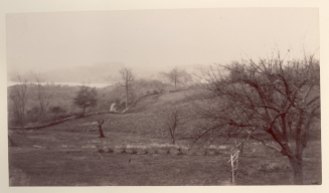The following was originally published in Harvard Memorial Biographies, and later reproduced in the book Mudge Memorials, by Alfred MudgeAlfred Mudge, Boston 1868, pp. 370-382. I have included it here in its entirety, preserving the original spellings.

CRM, photo [CDV or carte de visite] taken by John Adams Whipple (Boston, MA).
________________________
Charles Redington Mudge
First Lieutenant 2d Mass. Vols. [Infantry], May 25, 1861; Captain, July 8, 1861; Major, November 9, 1862; Lieutenant-Colonel, June 6, 1863; killed at Gettysburg, Pa., July 3, 1863.
Charles Redington Mudge was the son of Enoch Redington and Caroline A. (Patten) Mudge. He was born in New York City, on the 22d day of October, 1839. He studied for several years at the private school of Mr. Thomas G. Bradford, at that time a favorite teacher in Boston; and went thence to Harvard College in the summer of 1856, joining the Class of 1860. The most salient point in his college career was, beyond question, his exceeding popularity,—a popularity of an unusual and very flattering nature, which made him an especial favorite in his own chosen circle, and also left him perhaps nearly the only man in the Class who could be sure of a kind word and friendly deed from every member. In his case, this popularity was founded upon a remarkable unwavering kindliness of nature. An instinct assured each classmate that there could be no chance of a word of harshness or of sarcasm from him. It was his nature to appreciate the good traits of every one. Each comrade felt that Mudge saw the bright side of his character, and recognized all his best qualities. He had many accomplishments, too, of a nature highly esteemed by young and old. He had a good voice and ear, and sung with spirit from an inexhaustible repertory. He was lithe, muscular, and athletic in build, and very. fond of manly sports and exercises. He was a good oarsman, an excellent boxer, and distinguished in the Gymnasium. During nearly the whole of his college course he belonged to a club‑table, very many of the members of which have since won for themselves honorable names in the war, of whom Colonels Rob’t G. Shaw, Caspar Crowninshield and Henry S. Russell may be mentioned as perhaps the most conspicuous. He was an active and prominent member of the Glee Club, and a leading “brother” of the Hasty Pudding Club. Of the last he was also, during one term, Vice‑President.
After graduating he made preparations for entering the manufacturing business, in which his father’s prominent position gave him promise of an excellent opening. But the breaking out of the war at once changed his occupation, his objects, and his destiny. Every dweller in Boston and vicinity must have a fresh personal recollection of the prompt emulation with which young men from Boston and its neighborhood hastened to solicit commissions in the Second Regiment of Massachusetts Volunteers; and among these Mudge was enrolled from the outset, his commission as First Lieutenant bearing date May 26,1861. He wrote, Nov. 16,1862, looking back to these opening scenes:—
If you will just look back to that Sunday morning when you and I jumped out of our beds at the news of the capture of Fort Sumter,—I fully made up my mind to fight; and when I say fight, I mean win or die. I do not wish to stop the thing half‑way. I wish to establish the government upon a foundation of rock.
The results of this earnest trust and stern intent were marked and admirable in him, as in so many others. Boyish things were put off, and their place was filled by a thoughtfulness, a depth of moral conviction, and a steadiness of moral purpose, not often to be found in a young man scarce twenty‑two years of age.
Continue reading →




















































